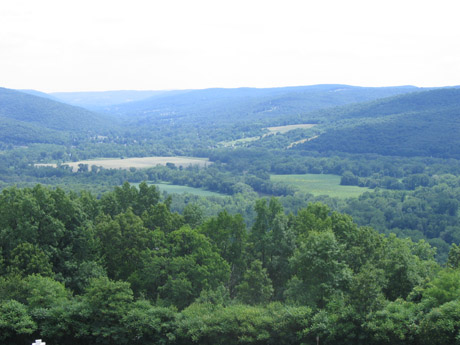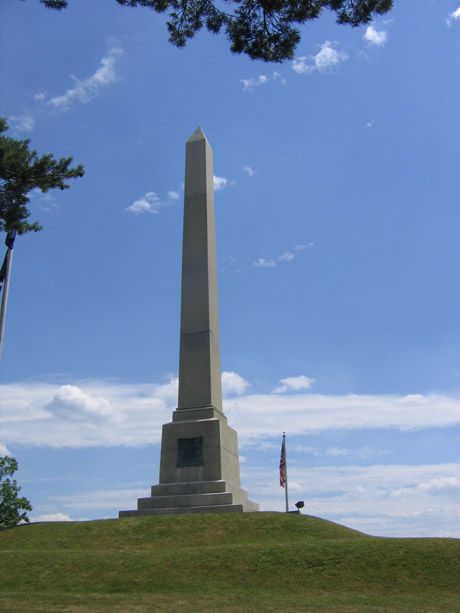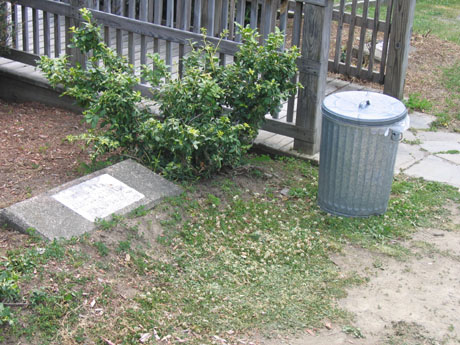Now we’re in Pennsylvania on the New York state line. We see the in-laws, my wife has lots of good fun with her family, the kids hang out with cousins. I sneak off to the bedroom to read some books on Gettysburg. Just finished Sear’s book.
I do manage to sneak away to a…. GASP…. battlefield… A Revolutionary War one.
The Battle of Newtown, August 29, 1779
In August of 1779, the peace and tranquility of this forested hill was broken by the boom of cannons, the crack of musket fire, and the yells of Iroquois warriors. The Continental Army was engaged in battle with the British regulars, Loyalist rangers and 1000 Iroquois Indian warriors. The battle of Newtown was the decisive clash in one of the largest offensive campaigns of the American Revolution. This expedition, known as the Sullivan-Clinton Campaign, had been regarded as punishment to several tribes among the Six Nations of the Iroquois Confederacy who had sided with the British in the war and had attacked frontier settlements
A stone monument was dedicated at the top of the hill on August 29, 1879, the centennial of the Battle of Newtown. The present granite monument was erected in 1912. During the 1930s, Civilian Conservation Corps crews built and developed many of the present facilities of the park, including a beautiful, rustic lodge. In 1973, Newtown Battlefield Reservation was designated as a historic landmark and placed on the National Register of Historic Places.
Battlefield map:
Photo looking south towards the battlefield from the monument:

Lieut. Col. Adam Hubley’s account of the day
Sunday, August 29th.”This morning at 9 o’clock the army moved in the same order of the 26th; the riflemen were well scattered in front of the light corps, who moved with the greatest precision and caution. On our arrival near the ridge on which the action of the 13th commenced with light corps, our van discovered several Indians in front, one of whom gave them a fire, and then fled. We continued our march for about one mile; the rifle corps entered a low marshy ground which seemed well calculated for forming ambuscades; they advanced with great precaution, when several more Indians were discovered, who fired and retreated. Major Parr, from those circumstances, judged it rather dangerous to proceed any further without taking every caution to reconnoitre almost every foot of ground, and ordered one of his men to mount a tree and see if he could make any discoveries; after being some time on the tree he discovered the movements of several Indians, (which were rendered conspicuous by the quantity of paint they had on them,) as they were laying behind an extensive breastwork, which extended at least half a mile, and most artfully covered with green boughs, and trees, having their right flank secured by the rirer, and their left by a mountain. It was situated on a rising ground, about one hundred yards in front of a difficult stream of water, bounded by the marshy ground already mentioned on our side and on the other, between it and the breast-works’ by an open and clear field. Major Parr immediately gave intelligence to General Hand of his discoveries, who immediately advanced the light corps within about three hundred yards of the enemy’s works, and formed in line of battle; the rifle corps, under cover, advanced, and lay under the bank of the creek within one hundred yards of the lines. Gen. Sullivan, having previous notice, arrived with the main army, and ordered the following disposition to take place: The rifle and light corps to continue their position; the left flanking division, under command of Colonel Ogden, to take post on the left flank of the light corps, and General Maxwell’s brigade, some distance in the rear, as a corps de reserve, and Colonel Proctor’s artillery in front of the centre of the light corps, and immediately opposite the breast-work. A heavy fire ensued between the rifle corps and the enemy, but little damage was done on either side. In the meantime, Generals Poor and Clinton’s brigades, with the right flanking division, were ordered to march and gain, if possible, the enemy’s flank and rear, whilst the rifle and light corps amused them in front. Col. Proctor had orders to be in readiness with his artillery and attack the lines, first allowing a sufflcient space of time to Generals Poor, &c., to gain their intended stations. About 3 o’olock, P. M., the artillery began their attack on the enemy’s works, the rifle and light corps in the meantime prepared to advance and charge; but the enemy, finding their situation rather precarious, and our troops determined, left and retreated from their works with the greatest precipitation, leaving behind them a number of blankets, gun covers, and kettles, with corn boiling over the fire. Generals Poor, &c., on account of several difficulties which they had to surmount, could not effect their designs, and the enemy probably having intelligence of their approach, posted a number of troops on the top of a mountain, over which they had to advance. On their arrival near the summit of the same, the enemy gave them a fire, and wounded several officers and soldiers. General Poor pushed on and gave them a fire as they retreated, and killed five of the savages. In the course of the day we took nine scalps, (all savages,) and two prisoners, who were separately examined, and gave the following corresponding account. that the enemy were seven hundred men strong, viz.. five hundred savages, and two hundred Tories, with about twenty British troops’ commanded by a Seneca chief, the two Butlers, Brandt, and M’Donald.
The infantry pushed on towards Newtown; the main army halted and encamped near the place of action near which were several extensive fields of corn and other vegetables. About 6 o’clock, P. M., the infantry returned and enecamped near the main army.
The prisoners further informed us that the whole of their party had subsisted on corn only for this fortnight past, and that they had no other provisions with them; and that their next place of rendezvous would be at Catharines town, an Indian village about twenty-five miles from this place.
Distance of march (exclusive of counter-marches) this day, about eight miles.
The Monument:

Here’s what happens if you lose a battle, your monument goes next to the trash can:

Just kidding, I think this was Clinton’s monument. Poor fellow…
So after 5 days we were off and onward to Gettysburg…
battle_map.JPG)